2024Activity reportProject-TeamMEMPHIS
RNSR: 201521153G- Research center Inria Centre at the University of Bordeaux
- In partnership with:Université de Bordeaux
- Team name: Modeling Enablers for Multi-PHysics and InteractionS
- In collaboration with:Institut de Mathématiques de Bordeaux (IMB)
- Domain:Applied Mathematics, Computation and Simulation
- Theme:Numerical schemes and simulations
Keywords
Computer Science and Digital Science
- A6. Modeling, simulation and control
- A6.1.1. Continuous Modeling (PDE, ODE)
- A6.1.5. Multiphysics modeling
- A6.2.1. Numerical analysis of PDE and ODE
- A6.3.1. Inverse problems
- A6.3.2. Data assimilation
- A6.3.4. Model reduction
- A6.5.1. Solid mechanics
- A6.5.2. Fluid mechanics
- A9.2. Machine learning
Other Research Topics and Application Domains
- B2.2.1. Cardiovascular and respiratory diseases
- B4.2. Nuclear Energy Production
- B4.3.2. Hydro-energy
- B4.3.3. Wind energy
- B5.2.3. Aviation
- B5.2.4. Aerospace
- B5.5. Materials
1 Team members, visitors, external collaborators
Research Scientists
- Michel Bergmann [INRIA, Senior Researcher]
- Michele Giuliano Carlino [ONERA, Researcher]
- Alessia Del Grosso [INRIA, ISFP]
- Tommaso Taddei [INRIA, Researcher]
Faculty Members
- Angelo Iollo [Team leader, UNIV BORDEAUX, Professor Delegation]
- Afaf Bouharguane [UNIV BORDEAUX, Associate Professor]
Post-Doctoral Fellows
- Umberto Bosi [INRIA, Post-Doctoral Fellow, until Mar 2024]
- Joyce Ghantous [INRIA, Post-Doctoral Fellow, from Oct 2024]
PhD Students
- Eki Agouzal [EDF, until Mar 2024]
- Beatrice Battisti [ECOLE POLYT. TURIN, until Apr 2024]
- Maxime Chapron [ONERA]
- Elise Declerck [ONERA, from Jun 2024]
- Jon Labatut [ONERA]
- Caroline Anna-Lise Andrea Le Guern [IFPEN, until Nov 2024]
- Karl Maroun [UNIV POITIERS, from Nov 2024]
- Karl Maroun [UNIV POITIERS, until Oct 2024]
- Abdessamad Moussaddak [EDF, CIFRE]
- Marc-Olivier Potin [ONERA, from Nov 2024]
- Michele Romanelli [ONERA, until Sep 2024]
- Ludovica Saccaro [INRIA, until Jan 2024]
- Alexis Tardieu [UNIV BORDEAUX, ATER, from Oct 2024]
- Alexis Tardieu [UNIV BORDEAUX, until Sep 2024]
- Mathias Truel [INGELIANCE, CIFRE]
- Alexis Valls [INRIA, from Nov 2024]
Interns and Apprentices
- Emanuela Dotti [INRIA, Intern, until Feb 2024]
- Haytham Elbada [INRIA, Intern, from Jun 2024 until Sep 2024]
- Sylvain Fourcade [INRIA]
- Marc-Olivier Potin [ONERA, from Oct 2024 until Nov 2024]
Administrative Assistant
- Anne-Laure Gautier [INRIA]
Visiting Scientists
- Laura Balasso [OPTIMAD, from Sep 2024 until Oct 2024]
- Fausto Dicech [OPTIMAD, until Jul 2024]
- Francesco Fabbri [GSSI, until Mar 2024]
- Harshith Gowrachari [SISSA, from Jul 2024 until Sep 2024]
- Sandro Malusa [OPTIMAD, until Jul 2024]
- Anna Spagnolo [OPTIMAD, from Sep 2024 until Oct 2024]
- Zhongle Wen [ESTECO S.R.L, from Aug 2024 until Sep 2024]
External Collaborators
- Astrid Decoene [UNIV BORDEAUX, until Aug 2024]
- Philippe Depouilly [CNRS]
- Ludovica Saccaro [INRIA, from Mar 2024 until Jun 2024]
2 Overall objectives
2.1 Multi-physics numerical modeling
2.1.1 Reduced-order models: convergence between PDE models and data
Unprecedented opportunities exist to directly use already collected computational or experimental data to improve and build predictive models that can be used online for the simulation of parametric problems, robust design, and control in science and engineering. In this regard, our goal is to combine mechanistic causal models based on partial differential equations (PDEs) with large data sets to reduce the marginal cost of predictions.
Reduced-order models (ROMs) are our main tool for this purpose. ROMs are parametric mathematical models derived from the full set of PDEs using previously computed solutions. In many applications, the solution space turns out to be low-dimensional, so one can trade a minimal loss of accuracy for speed and scalability. ROMs counteract the curse of dimensionality by significantly reducing computational complexity.
Overall, ROMs have reached a certain level of maturity during the last decade, allowing their implementation in large-scale industrial codes, mainly in structural mechanics. Nevertheless, some hard points stand. Parametric problems governed by strong advection fields or sensibly compact-support solutions such as moving shocks suffer from a limited possibility of dimensional reduction and, at the same time, insufficient generalization of the model (out-of-sample solutions). The main reason for this is that the solution space is usually approximated by an affine or linear representation, which is intrinsically broad band for such problems.
We have worked on the development of model order reduction (MOR) techniques for nonlinear, advection-dominated problems, with emphasis on projection-based Galerkin and Petrov-Galerkin ROMs. First, we worked on the development of effective sampling strategies to reduce training costs. Second, we developed nonlinear, registration-based approximation techniques, to overcome limitations of linear approximation methods (e.g., proper orthogonal decomposition, POD) to deal with strong advection fields. Third, we developed hybrid formulations that combine reduced-order and full-order models to deal with complex flow features and/or complex parameterizations.
2.1.2 Schemes for Hierarchical meshes, multi-physics and asymptotic limits
The schemes we have developed aim at simulating complex multiphysics phenomena through appropriate PDE modeling, automatic implicit geometry representation (level sets), hierarchical Cartesian schemes (quad-octrees), parallel simulations, and accurate treatment of boundaries. Discretization schemes on hierarchical meshes allow multiscale solution of PDEs on non-body-fitted meshes with a drastic reduction in computational setup overhead. The key idea is to use an octree mesh to approximate the solution fields, while the geometry is captured by level set functions. The boundary conditions are determined by appropriate interpolation methods to achieve sufficient accuracy. This approach eliminates the need for boundary conforming meshes, which require time-consuming and error-prone mesh generation procedures, and opens the door to easy parallel simulation of very complex geometries.
One of the limitations of this approach is that a mesh with a fixed aspect ratio is not optimal for very anisotropic fields such as boundary layers. For such cases, we explored the idea of using a body-fitted grid near the immersed obstacles and a hierarchical mesh in the background. Essentially, we use the techniques we have developed to impose boundary conditions on non-body-matched meshes further from the boundary, where the solution is smoother and more isotropic. Our current investigations build on discontinuous Galerkin (DG) methods / ADER approaches to combine efficient interpolation strategies at the grid interfaces and compact reconstruction of the data at the grid level.
Part of our activity has been dedicated to improve schemes for all Mach number flows in both fluid dynamics and continuum mechanics. Phenomena of interest involve fluid flows and elastic materials whose deformations are investigated within a monolithic Eulerian framework. With this approach any material (gas, liquid or solid) can be described with the same system of conservation equations and a suitable general formulation of the constitutive law.
These schemes are accurate in computing steady state solutions as well as in approximating material wave propagation in various Mach regimes and different materials. We studied methods to overcome the need to solve for auxiliary relaxation variables while preserving the properties of the linearly implicit schemes. To achieve this, we split the stiff relaxation source terms from the fluxes and then reformulate the homogeneous part in an elliptic form. Further research on obtaining all Mach methods by including multi-dimensional knowledge in the numerical scheme is also being conducted. More specifically, we envisage to exploit a nodal pressure that depends on all the cells around the given node and naturally encompasses a consistent discretization of the divergence of the velocity vector.
3 Research program
Coherently with our investigation approach, we start from real-world applications to identify key methodological problems, then, we study those problems and develop new methods to address them; finally, we implement these methods for representative test cases to demonstrate their practical relevance.
3.1 Numerical models
We aim to further develop automated model-order reduction (MOR) procedures for large-scale systems in computational mechanics — here, automated refers to the ability to complete the analysis with minimal user intervention. First, we wish to combine nonlinear MOR with mesh adaptation to simultaneously learn rapid and reliable ROMs and effective high-fidelity discretizations over a range of parameters. Second, we wish to develop component-based MOR procedures to build inter-operable components for steady and unsteady nonlinear PDEs: towards this end, we should develop efficient localized training procedures to build local ROMs for each archetype component, and also domain decomposition techniques to glue together the local models for prediction. We also wish to develop and analyze hybrid approaches that combine and merge first-principle models with data-fit models, and also full-order and reduced-order models for prediction of global engineering quantities of interest.
We envision that several methods that are currently developed in the team can be complemented by available tools from machine learning: representative examples include — but are not limited to — solution clustering, optimal sampling, classification. In this respect, a leap forward in industrial applications that we will pursue is without doubts the possibility of capitalizing on previous experience drawn from already acquired simulations to build non-intrusive models that combine non-linear interpolations and non-linear regression. New perspectives in this direction are offered by the Chair Onera-Nouvelle Aquitaine (cf. Regional initiatives).
As regards the work on numerical discretization of PDEs, compared to the previous evaluation, we focus on the representation of the solution in each computational cell by adopting a DG/ADER approach to improve the resolution of solution's discontinuities. This approach is complemented with a Chimera grid at the boundaries in order to improve accuracy by a body fitted mesh avoiding grid generation complexity for a general, possibly varying, geometrical topology. The thesis of Alexis Tardieu, which started in October 2021 and is funded by the University of Bordeaux, studies this approach.
In parallel, we continue our exploration of schemes in asymptotic regimes such as low- and high Mach numbers for multi-material flows. We aim for schemes that circumvent the problem of accuracy and time stepping in such regimes: the ultimate goal is to devise asymptotic-preserving schemes that are able to capture phenomena at the time scale of the fast waves and of the material waves with the same accuracy. For such a purpose, a new path based on numerical schemes with multi-dimensional knowledge is also being explored.
3.2 Applications
For energy applications, we will continue our investigations on wave energy converters and windturbines. Relative to wave energy converters, we are developing multifidelty models that couple the incompressible Navier-Stoke equations (NSE) around the floater with a Proper Orthogonal (POD) ROM or a simplified-physics model elsewhere.
- In October 2021, Nishant Kumar started a two-year postdoctoral fellowship in the team, which was funded by the Inria-IfpEN program; the aim is to couple an high-fidelity model and a POD model based on the LES Navier-Stokes equations; the coupling is implemented in the SOWFA framework of OpenFOAM.
- In December 2021, Caroline Le Guern started her PhD in the team, in the framework of the Inria-IfpEN program; Caroline works on the modeling and simulation of the fluid-structure interaction of next-generation windturbines with up to 250 meter rotor; the numerical implementation is based on the software Deeplines that is co-developed by IfpEN.
- In April 2022, Umberto Bosi started a two-year postdoctoral fellowship in the team, in collaboration with CARDAMOM: the project of Umberto, which was funded by Inria and the Region Nouvelle Aquitaine, focuses on the coupling between an high-fidelity (e.g., Navier-Stokes) model and an asymptotic (e.g., shallow water or Boussinesq) model.
We are also collaborating with EDF to devise effective ROMs for parametric studies. In this collaboration, we emphasize the implementation of projection-based ROMs for real-world applications exploiting industrial codes.
- In April 2021, Eki Agouzal started an industrial thesis to develop projection-based ROMs for nonlinear structural mechanics problems in Code Aster, with emphasis on thermo-hydro-mechanical (THM) applications.
- In December 2023, Abdessamad Moussaddak started his PhD thesis on model reduction for river and coastal hydraulics.
Within the ARIA project, in collaboration with Nurea and the bio-mechanics lab of the Politecnico di Torino, we investigate the idea of data augmentation starting from a given aneurysm database. We construct statistically relevant synthetic aneurysms that can provide both heterogeneity and closeness to reality to test new bio-markers for aneurysm rupture. The thesis of Ludovica Saccaro funded by Inria is dedicated to this subject.
In the framework of the ANR DRAGON, we also increase our interactions with researchers in biology and physical science. in the center of biological studies in Chizé (centre d'études biologiques de Chizé). The ANR funds the PhD thesis of Karl Maroun at University of Poitiers.
The software development will be continued. We will pursue the development of the NEOS library: NEOS will be distributed in open source LGPL-3.0. The HIWIND software will be rewritten based on NEOS library.
4 Application domains
4.1 Energy conversion
We apply the methods developed in our team to the domain of wind engineering and sea-wave converters. In Figure 1, we show results of a numerical model for a sea-wave energy converter. We here rely on a monolithic model to describe the interaction between the rigid floater, air and water; material properties such as densities, viscosities and rigidity vary across the domain. The appropriate boundary conditions are imposed at interfaces that arbitrarily cross the grid using adapted schemes built thanks to geometrical information computed via level set functions 52. The background method for fluid-structure interface is the volume penalization method 36 where the level set functions is used to improve the degree of accuracy of the method 4 and also to follow the object. The underlined mathematical model is unsteady, and three dimensional; numerical simulations based on a grid with degrees of freedom are executed in parallel using 512 CPUs.
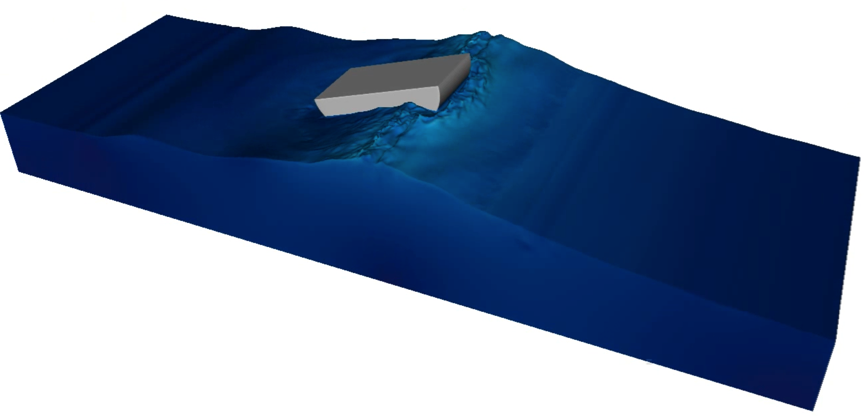
See-wave converter
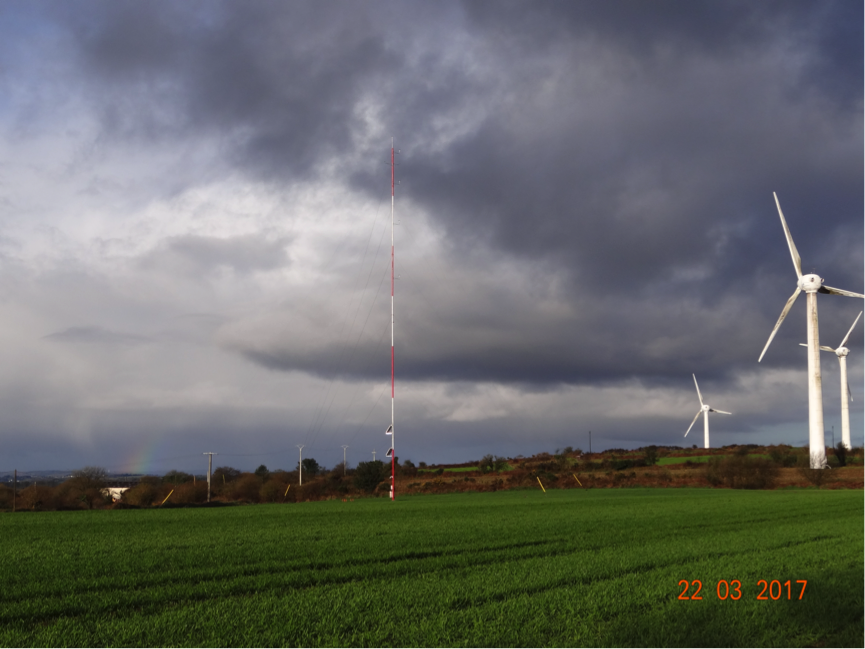
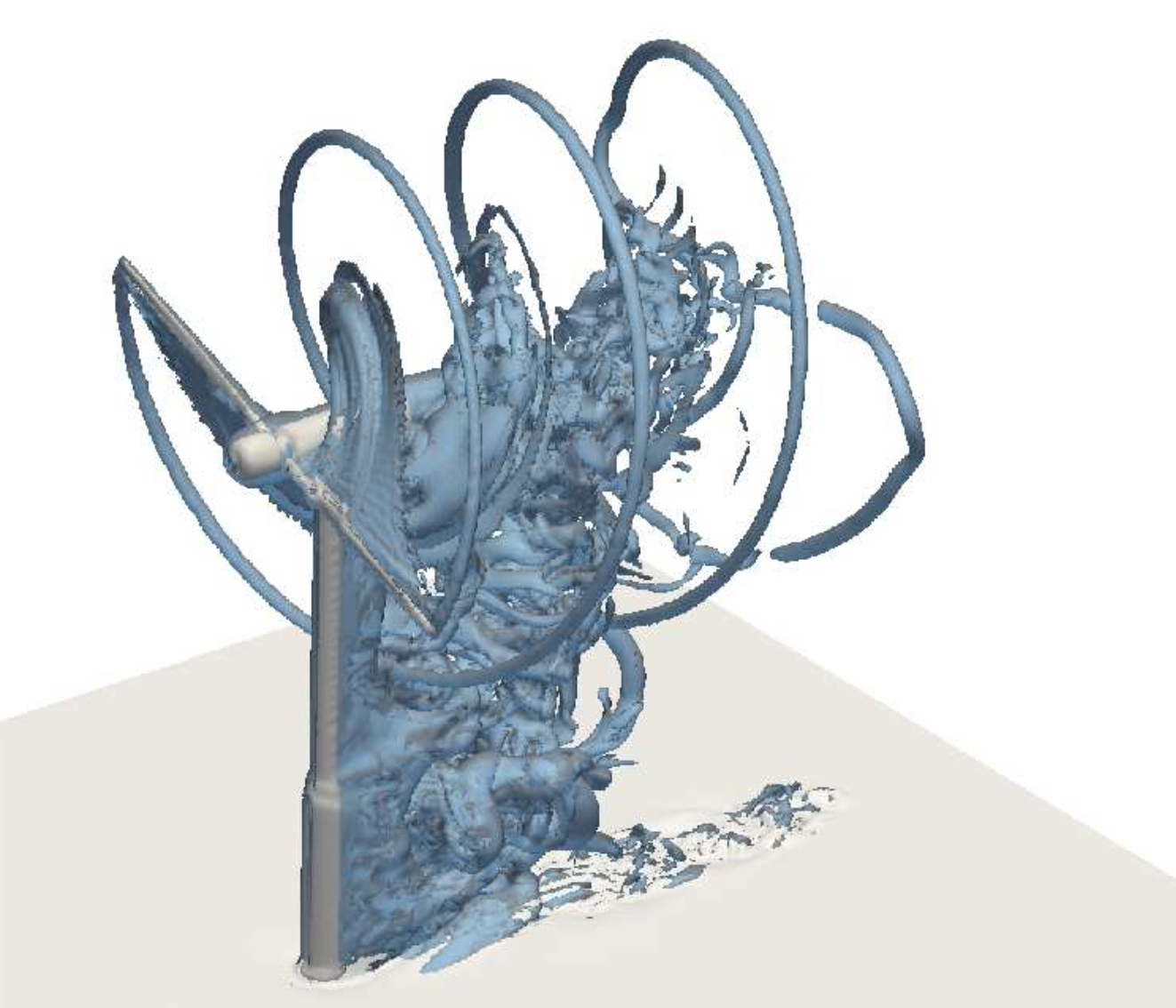
Wind turbine
In the context of the Aerogust (Aeroelastic gust modelling) European project, together with Valorem, we investigated the behavior of wind turbine blades under gust loading. The aim of the project was to optimize the design of wind turbine blades to maximize the power extracted. A meteorological mast (Figure 2(a)) has been installed in March 2017 in Brittany to measure wind on-site: data provided by the mast have been exploited to initialize the mathematical model. Due to the large cost of the full-order mathematical model, we relied on a simplified model 50 to optimize the global twist. Then, we validated the optimal configuration using the full-order Cartesian model based on the NaSCar solver. Figure 2(b) shows the flow around the optimized optimized wind turbine rotor.
4.2 Schemes for turbulent flow simulations using Octrees
We have initially developed and tested a 3D first-order Octree code for unsteady incompressible Navier-Stokes equations for full windmill simulations with an LES model and wall laws. We have validated this code on Occigen for complex flows at increasing Reynolds numbers. This step implied identifying stable and feasible schemes compatible with the parallel linear Octree structure. The validation has been conducted with respect to the results of a fully Cartesian code (NaSCAR) that we run on Turing (with significantly more degrees of freedom) and with respect to experimental results.
Subsequently, we have developed a second-order Octree scheme that has been validated on Occigen for a sphere at a moderate Reynolds number (), see Table 1. Then, for a cylinder at () (Figures 3(a) and 3(b)), close to real applications, we have preliminary validation results for the second-order scheme with respect to experimental drag coefficient (Table 2). Additional resources will be asked on Occigen to complete the study.
| Mesh | number of cells | (1st-order scheme) | (2nd-order scheme) | |
| 1 | N.A. | |||
| 2 | ||||
| 3 | ||||
| 4 |
| Case | |
| Octree, 1st-order scheme | |
| Octree, 2nd-order scheme | |
| Cartesian | |
| Experimental estimate 42 |

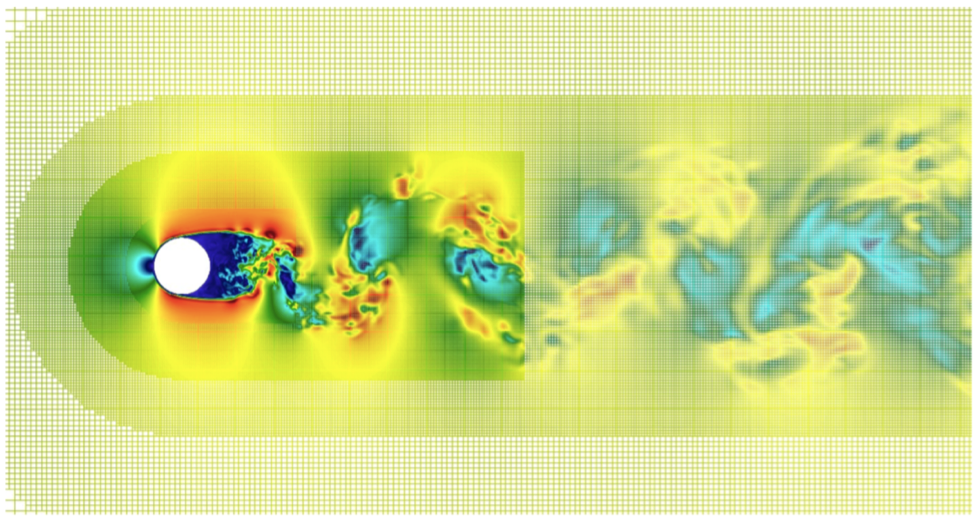
Turbulent simulations
4.3 Vascular flows
A new research direction pursued by the team is the mathematical modelling of vascular blood flows in arteries. Together with the start-up Nurea and the surgeon Eric Ducasse, we aim at developing reliable and automatic procedures for aneurysm segmentation and for the prediction of aneurysm rupture risk. Our approach exploits two sources of information: (i) numerical simulations of blood flows in complex geometries, based on an octree discretization, and (ii) computed tomography angiography (CTA) data. Figure 4 shows the force distribution on the walls of the abdominal aorta in presence of an aneurysm; results are obtained using a parallelized hierarchical Cartesian scheme based on octrees.
Further information is given in the sections dedicated to the new results.
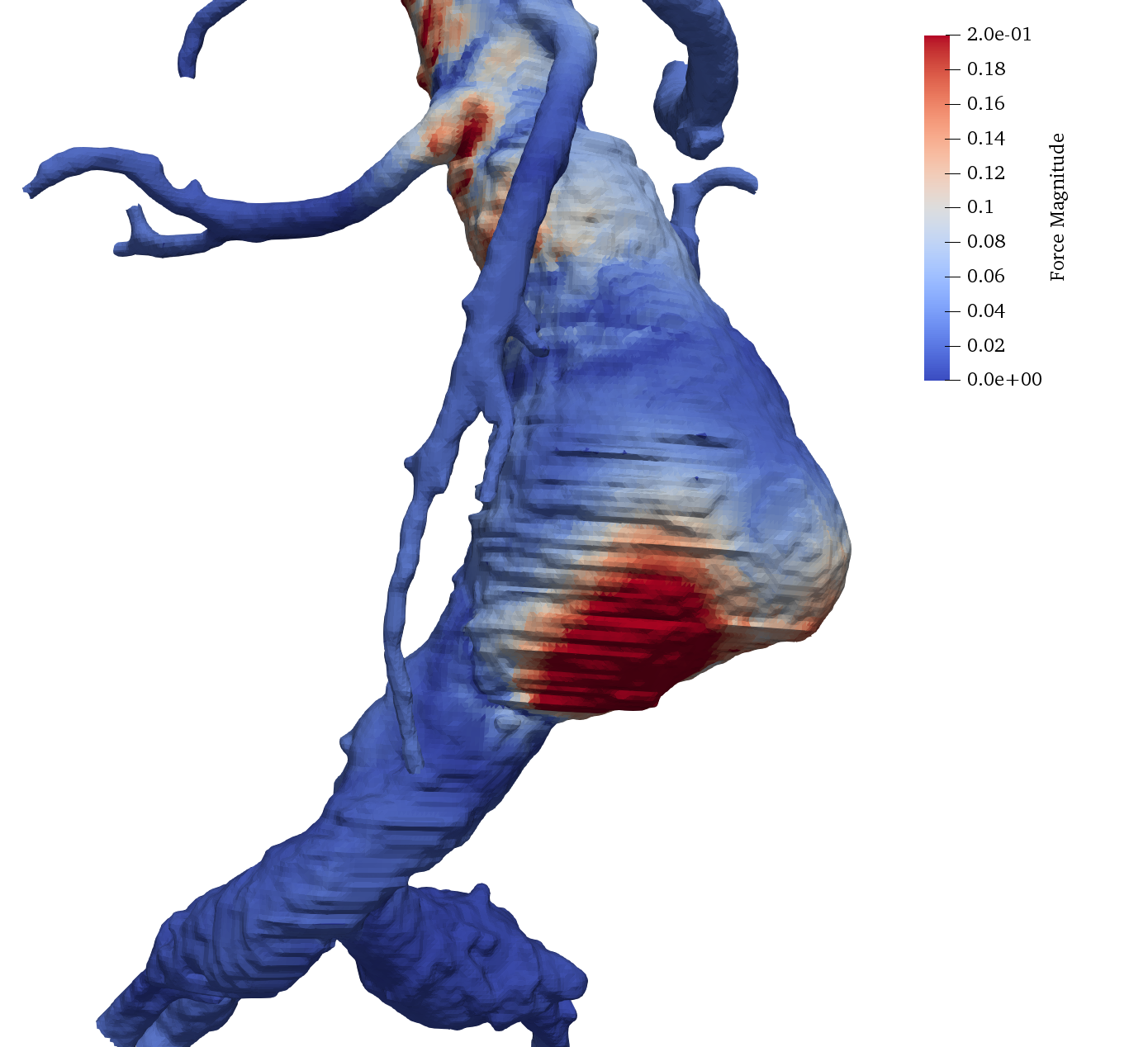
Aneurysm simulation
4.4 Fluid-structure interactions using Eulerian non-linear elasticity models
Mathematical and numerical modeling of continuum systems undergoing extreme regimes is challenging due to the presence of large deformations and displacements of the solid part, and due to the strongly non-linear behavior of the fluid part. At the same time, proper experiments of impact phenomena are particularly dangerous and require expensive facilities, which make them largely impractical. For this reason, there is a growing interest in the development of predictive models for impact phenomena.
In MEMPHIS, we rely on a fully Eulerian approach based on conservation laws, where the different materials are characterized by their specific constitutive laws, to address these tasks. This approach was introduced in 48 and subsequently pursued and extended in 51, 46, 37, 40 and 9. In Figure 5, we show the results of the numerical simulation of the impact of a copper projectile immersed in air over a copper shield. Results are obtained using a fully parallel monolithic Cartesian method, based on a fixed Cartesian grid. Simulations are performed on a cluster of 512 processors, and benefits from the isomorphism between grid partitioning and processor topology.
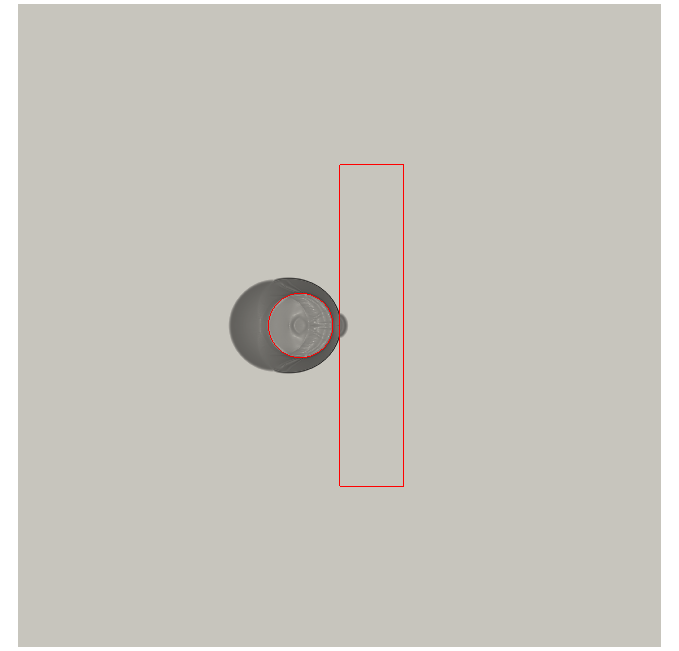
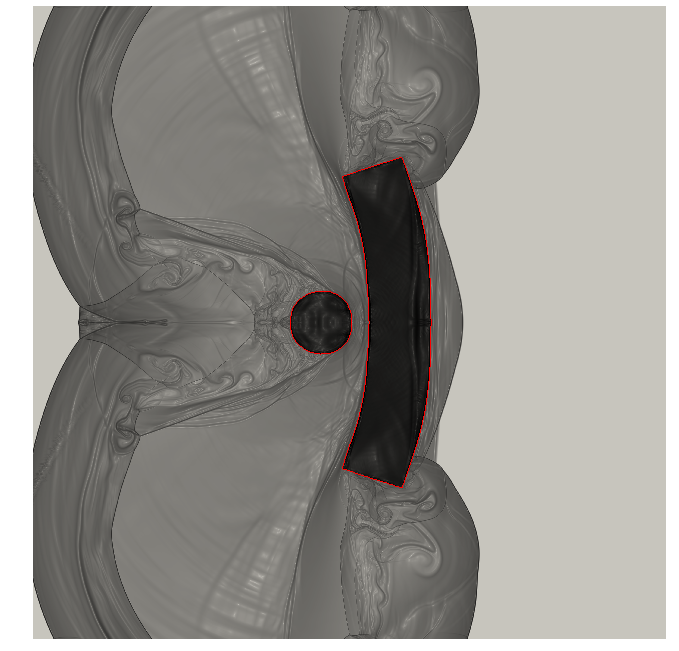
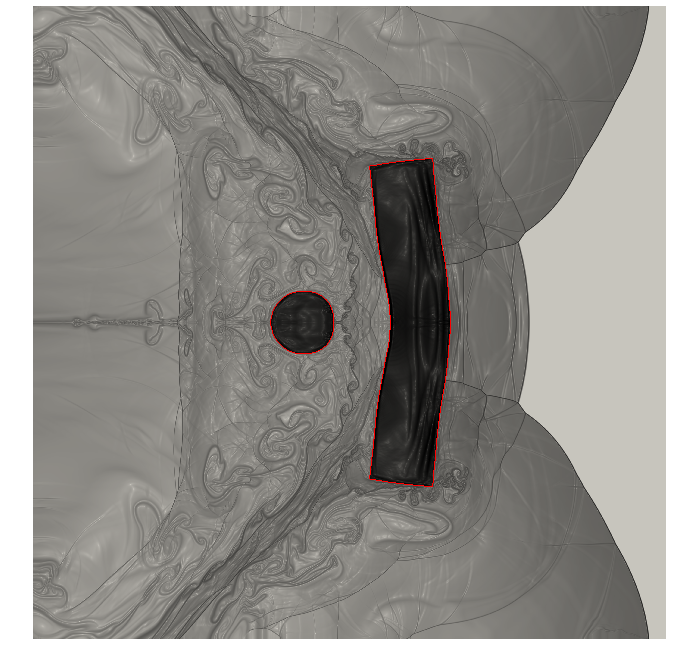
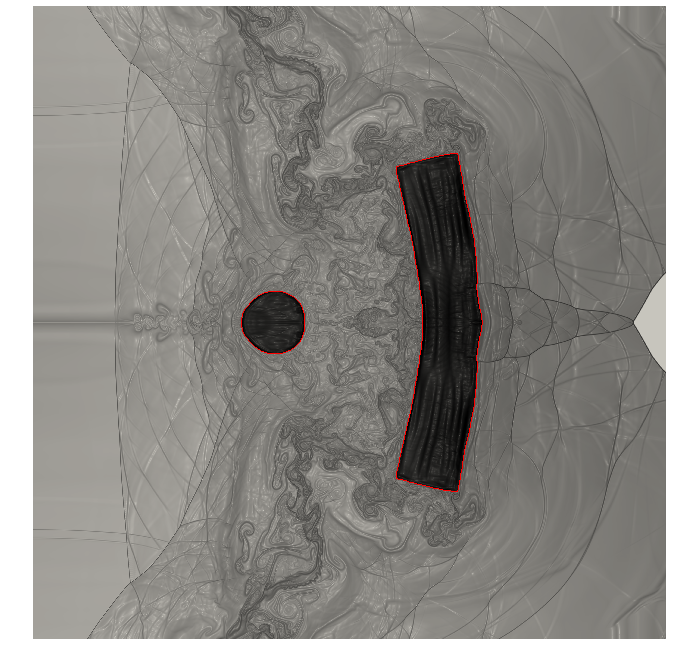
Impact simulation
In figure 6, we show the results of a three dimensional simulation of a cardiac pump (LVAD, left ventricule assisted device).
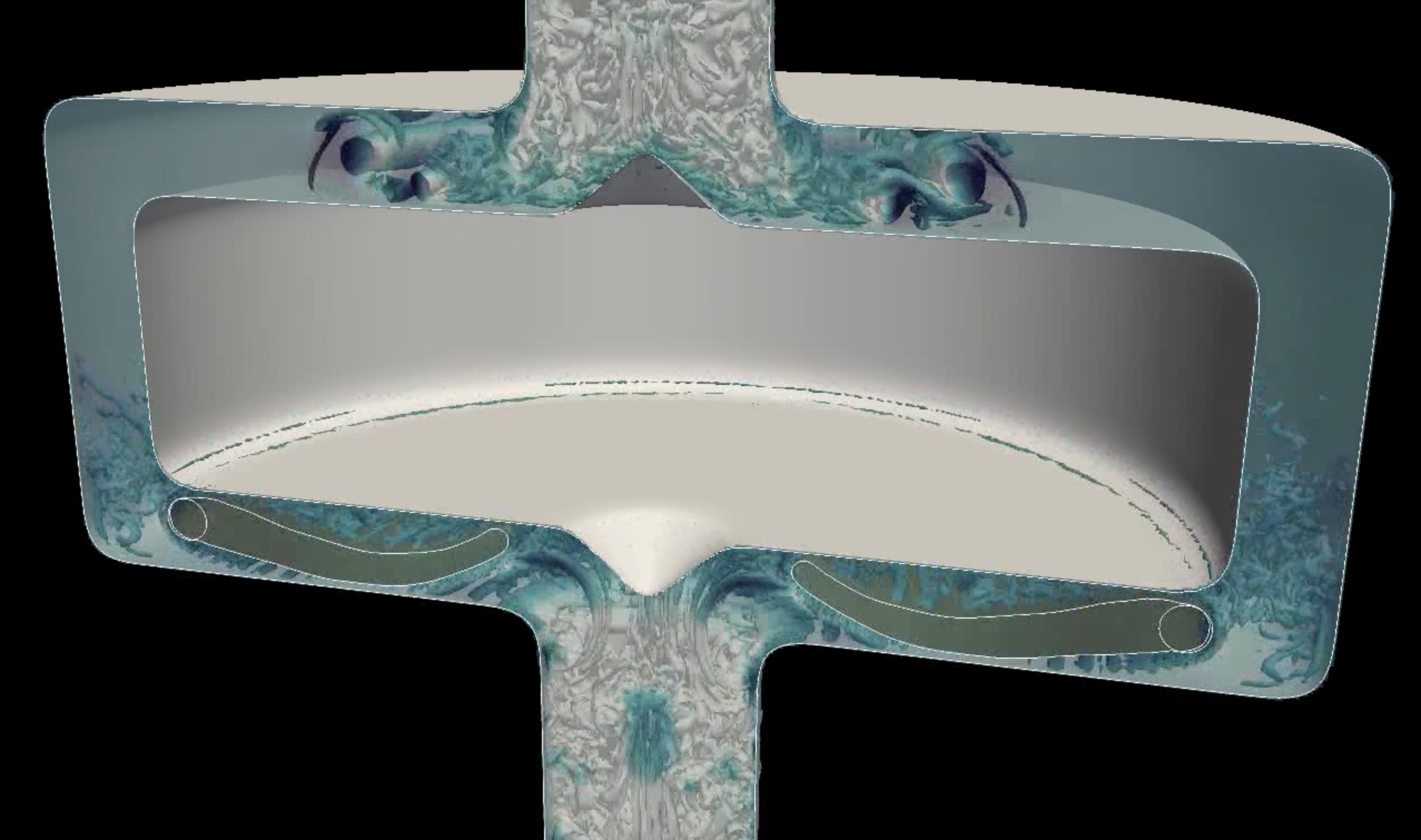
Cardiac pump simulation
5 Social and environmental responsibility
As discussed in the previous section, we are particularly interested in the development of mathematical models and numerical methods to study problems related to renewable energies, and ultimately contribute to next-generation sustainable solutions for energy extraction.
5.1 Impact of research results
We are studying two types of green energy extractors: wave energy converters (WECs) and wind energy.
As regards WECs, we are working with the PoliTO (Torino, Italy) to model the behavior of inertial sea wave energy converters (ISWEC), and we are also working with a Bordeaux-based start-up for another device to extract energy from waves via an Inria-Tech project and a Nouvelle-Aquitaine Regional Project submitted by Memphis in collaboration with the CARDAMOM team.
As regards wind energy, we focus on the analysis of wind turbines. In the past, we have supervised two PhD CIFRE theses with VALOREM-Valeol, and are currently working with them in a European RISE ARIA project led by Memphis. We also work with IFPEN on the aeroelastic modeling of large wind turbines and the study and optimization of turbines farms in the framework of the joint laboratory Inria-IFPEN with a thesis funded by IFPEN and a post-doc funded by Inria (which started in October 2021).
In conjunction with these activities, in collaboration with ANDRA (the national agency for storage of nuclear waste), we investigated the development of reduced-order models to allow efficient and accurate simulations for deep geological storage planning. This activity was the subject of the PhD thesis of Giulia Sambataro who successfully defended her PhD thesis in December 2022.
6 Highlights of the year
6.1 Summer school CEA-EDF-Inria
In July 2024, Angelo Iollo, Michel Bergmann, and Tommaso Taddei organized the CEA-EDF-Inria summer school on numerical analysis entitled “Reduced Order Models: Bridging PDE Models and Simulation Data”. The school was attended by approximately 40 participants, including researchers from EDF, CEA and Inria, and PhD students from both national and international institutions. The topics covered in the lectures will be the subject of an upcoming book “Advances in Model Order Reduction: Linear and Non-Linear Perspectives” that will be published by Springer.
Further information on the summer school together with the program is available on the website of the conference.
6.2 Nonlinear approximations based on coordinate transformations
A significant limitation of state-of-the-art model order reduction (MOR) techniques that rely on linear approximation spaces is their inability to effectively handle parameter-dependent sharp gradients, which are characteristic of solutions to advection-dominated problems. This inadequacy of linear approximations has spurred the development of nonlinear methods. Among these, nonlinear approaches based on coordinate transformations have demonstrated their effectiveness across a wide range of problems in computational mechanics.
To address this issue, we propose a registration technique to align local features in a fixed reference domain. In computer vision and pattern recognition, registration refers to the process of finding a transformation that aligns two datasets; here, registration refers to the process of finding a parametric spatio-temporal transformation that improves the linear compressibility of the solution manifold.
During the past five years, several researchers of team MEMPHIS have developed MOR techniques based on coordinate transformations. In particular, in 53 we introduced an optimization framework for the problem of identifying a parametric bijection that adequately tracks the location of coherent structures (shocks, wakes, shear layers) of the solution field. This problem is referred to as registration due to its connection with registration methods in computer vision and pattern recognition. Furthermore, in 49, we proposed a novel interpolation technique — referred to as convex displacement interpolation (CDI) — that is specifically designed for problems with compactly-supported and parameter-dependent coherent structures.
In 2024, we further developed the methods introduced in 53 and 49 with application to shock-dominated flows. In particular, in 14 Barral et al introduce a general framework that combines (i) parametric mesh adaptation for the construction of a common mesh for all configurations, (ii) registration for the construction of a parametric bijection that properly tracks the coherent structures of the solution field, and (iii) projection-based model reduction in parametric geometries to determine a reduced-order model of the solution field in the “reference” configuration. On the other hand, in 17, Cucchiara et al extend the CDI method of 49 to multi-dimensional parameterizations and to datasets with more than one parameters. A thorough review of these methods is contained in the HDR dissertation of Tommaso Taddei 28.
6.3 Collocated model order reduction
In 32, Bergmann et al. introduce an alternative to traditional projection-based Model Order Reduction (pMOR), called collocation-based Model Order Reduction (cMOR). Both techniques aim to reduce the computational cost of solving parametric Partial Differential Equations (PDEs), but cMOR differs in that it computes the solution at specific collocation points, identified through hyper-reduction techniques, instead of projecting residuals onto a reduced subspace. This approach simplifies implementation and ensures consistency with the underlying High-Dimensional Model (HDM).
The cMOR framework leverages the ADER method on moving Chimera grids 38, which is particularly suited for advection-diffusion problems and geometrically evolving domains. Chimera grids consist of overlapping mesh blocks, including a stationary background grid and moving foreground grids that align with domain boundaries or regions of interest. By solving the HDM locally on the moving foreground grids, the solution is naturally referenced to a moving frame, allowing it to capture advective features directly. This eliminates the need for a large number of reduced basis components, as the reduced basis is defined locally and adapt dynamically to the unsteady features of the solution.
This localized approach addresses the challenge posed by the slow -width Kolmogorov decay rate for convection-dominated problems, where represents the number of the components of the employed reduced basis. Unlike global basis, which struggle to represent sharp gradients or coherent structures efficiently, the use of moving foreground grids ensures that the reduced basis aligns with the dominant features of the solution, significantly improving computational efficiency without compromising accuracy. Moreover, this approach bypasses the need for bijective mappings or complex domain transformations, which are often computationally expensive and difficult to apply in general settings.
The paper 32 provides a detailed explanation of the construction of the chimera grid, the implementation of the ADER method, and the cMOR formulation. Numerical experiments demonstrate the effectiveness of this approach in reducing computational costs while maintaining accuracy, particularly for convection-dominated problems with time-dependent geometries.
The most evident result of the described method is shown by the following test case. It compares of the proposed cMOR approach using a chimera grid with a classical pMOR method for a purely advective PDE. The computational domain is periodic, and the initial condition is a localized bump centered at the origin of the axis with support in the unit circle. The bump can move alternately along horizontal and vertical lines, with velocity , where . The objective is to find a parametric numerical solution with respect to horizontal and veritical velocities and . In cMOR, the foreground mesh moves with the bump (see Fig. FIG), effectively aligning the reduced basis with its dynamics and reducing to only one collocation point (located at the maximum of the bump). This results in machine-precision errors with a single mode, as the bump appears stationary in the moving frame. In contrast, the pMOR approach (with a global basis) requires 25 modes, but still exhibits errors of . Singular value analysis confirms cMOR efficiency in capturing advection-dominated dynamics with minimal computational resources.
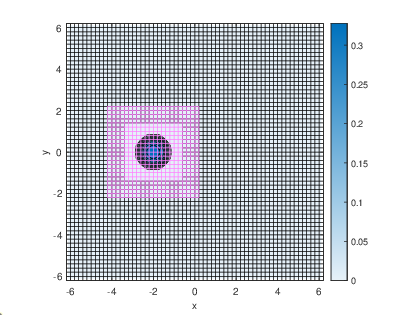
Particular configuration of a pure advection of a bump. In color is the foreground mesh that follows the displacement of the bump.
7 New software, platforms, open data
7.1 New software
7.1.1 COCOFLOW
-
Keywords:
3D, Elasticity, MPI, Compressible multimaterial flows
-
Functional Description:
The code is written in fortran 95 with a MPI parallelization. It solves equations of conservation modeling 3D compressible flows with elastic models as equation of state.
-
Contact:
Florian Bernard
-
Partners:
CNRS, Université Bordeaux 1
7.1.2 KOPPA
-
Name:
Kinetic Octree Parallel PolyAtomic
-
Keyword:
Numerical simulations
-
Functional Description:
KOPPA is a C++/MPI numerical code solving a large range of rarefied flows from external to internal flows in 1D, 2D or 3D. Different kind of geometries can be treated such as moving geometries coming from CAO files or analytical geometries. The models can be solved on Octree grids with dynamic refinement.
-
Contact:
Angelo Iollo
-
Participant:
Florian Bernard
7.1.3 NaSCar3D
-
Name:
Navier-Stokes Cartesian 3D
-
Scientific Description:
NaSCar can be used to simulate both hydrodynamic bio-locomotion as fish like swimming and aerodynamic flows such wake generated by a wind turbine.
-
Functional Description:
This code is devoted to solve 3D-flows in around moving and deformable bodies. The incompressible Navier-Stokes equations are solved on fixed grids, and the bodies are taken into account thanks to penalization and/or immersed boundary methods. The interface between the fluid and the bodies is tracked with a level set function or in a Lagrangian way. The numerical code is fully second order (time and space). The numerical method is based on projection schemes of Chorin-Temam's type. The code is written in C language and use Petsc library for the resolution of large linear systems in parallel.
NaSCar can be used to simulate both hydrodynamic bio-locomotion as fish like swimming and aerodynamic flows such wake generated by a wind turbine.
- URL:
-
Contact:
Michel Bergmann
-
Participant:
Michel Bergmann
7.1.4 NS-penal
-
Name:
Navier-Stokes-penalization
-
Keywords:
3D, Incompressible flows, 2D
-
Functional Description:
The software can be used as a black box with the help of a data file if the obstacle is already proposed. For new geometries the user has to define them. It can be used with several boundary conditions (Dirichlet, Neumann, periodic) and for a wide range of Reynolds numbers.
-
Contact:
Charles-Henri Bruneau
-
Partner:
Université de Bordeaux
7.1.5 HiWind
-
Keyword:
Simulation
-
Functional Description:
Hiwind is a software that allows to model in 2D and 3D the effects of air flow on a wind turbine blade (moving solid or elastic structures), and to simulate numerically their interactions. Hiwind also allows to model and characterize the abnormal behavior to warn about a potential weakening of the structure. Hiwind is a "drag and drop" solution (automated meshing phase), massively parallel, and uses adaptive meshing.
-
Contact:
Angelo Iollo
-
Partner:
Valeol
7.1.6 NEOS
-
Functional Description:
NEOS is a software framework for numerical modeling of multiphysical problems on hierarchical Cartesian meshes (quadtree in 2D and octree in 3D). It is mainly based on the bitpit library (https://optimad.github.io/bitpit/). NEOS provides : - the creation and parallel management of hierarchical Cartesian meshes (2D quadtree or 3D octree) - global or local mesh refinement (based on a distance of levelset or other physical criteria) - the management of several moving geometries in an analytical or explicit form (STL files or others) - the calculation of geometries levelsets at any point of the mesh - 2D/3D differential operators of (gradient, laplacian, hessian, ...) - various 2D/3D interpolators (bilinear, radial basis functions RBF) - an API for solvers (currently with PETSC) - a complete Python3 interface
-
Contact:
Michel Bergmann
8 New results
8.1 Multi-fidelity multi-scale numerical modeling of wave energy converter farms
Participants: Beatrice Battisti, Michel Bergmann.
High-fidelity three-dimensional models provide accurate results for wave energy converters (WECs) simulations, but are too computationally expensive. Projection-based model order reduction techniques based on Proper Orthogonal Decomposition (POD) have demonstrated effectiveness in simulating single-phase flows, but encounter stability challenges with multiphase flows. Tests presented in the thesis indicate that classical methods bypassing full-order models are not viable in this context. A multi-fidelity, Galerkin-free model is thus proposed, combining CFD for accurately describing the WEC near-field, with POD for efficient far-field wave propagation modeling. The two systems are coupled using a domain decomposition-inspired strategy (Figure 8), ensuring bidirectional information exchange for precise flow reconstruction and accurate representation of the floater dynamics. This approach has potential broader applications, serving as an advanced far-field boundary condition in problems involving wave propagation.
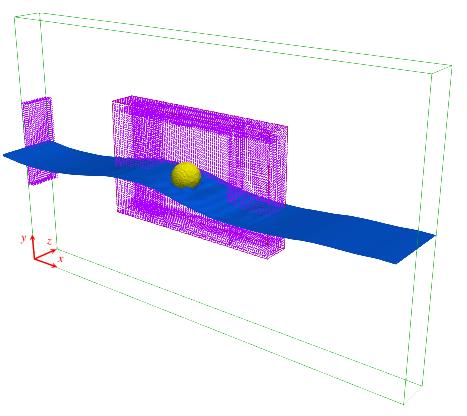
Snapshot of the air-water interface. The green domain represents a zoom on the entire simulation domain, the violet domains represent the total support of the coupling technique, given by both the overlapping domain (around the sphere) and a sensor locations for the incoming wave. The ratio of the coupling computational domain to the total simulation domain is , pointing out the significant CPU savings.
Numerical results on different wave conditions (Figure 9) prove the versatility of the coupling technique, both for in-sample reconstruction (IS, where the POD basis is computed with a database from the baseline condition ), and an out-of-sample prediction (OOS, where the POD basis is computed with a database from conditions and ).
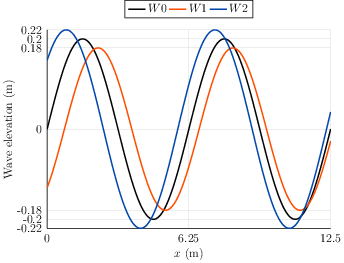
Visualization of the tested waves. The target wave, , has characteristics (wave height and wave period) equal to the mean of the characteristics of the other two waves, and , used for the OOS test.
In the OOS case, the L2 relative errors are slightly higher than those in the IS case but remain comparable, with all errors on the order of . The time evolution of the vertical translation of the floating body and the vertical force acting on it are shown in Figure 10.
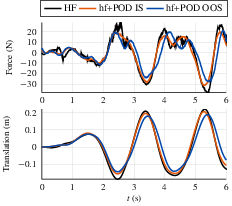
Evolution of the force acting on the sphere and the heave motion over time. The solutions from the coupled model (hf+POD) are compared to the high-fidelity solution used to build the basis functions (HF).
With only slight dissipation at the peaks and troughs, the IS case's temporal evolution of the force and body position nearly matches the one in the reference high-fidelity (HF) solution. Although the overall behavior is still accurate, there is a slightly larger difference between the reference and the predicted solution in the OOS case. In this case, there is an observable phase shift and a higher degree of dissipation, which may be impacted by the time step selected. The phase shift is likely due to the training dataset containing wave periods different from the target period. In addition to strong CPU savings, the computational time of the simulations passes from approximately 10 hours and 30 minutes on 48 processors, to less than 4 hours, using only 6 processors.
8.2 Reduced order models in quasi-static nonlinear mechanics for state estimation by calibration through data assimilation: application to containment buildings
Participants: Eki Agouzal, Michel Bergmann, Tommaso Taddei.
In the field of nuclear power plant management, Electricité de France (EDF) seeks to enhance its understanding of the mechanical state of containment buildings, especially for large pre-stressed concrete structures. To this end, extensive research has been conducted to develop robust thermo-hydro-mechanical (THM) models, specifically designed for modeling the aging of these large structures. However, the high costs of such simulations prohibit the use of iterative optimization methods to solve inverse problems.
To overcome this challenge, the PhD work of Eki Agouzal 24 first focused on the development of model reduction methods applied to nonlinear mechanics problems with internal variables. A methodology based on Proper Orthogonal Decomposition (POD) is implemented, combined with hyper-reduction via the ECSW method. These techniques are applied to a real industrial case: a current section of the containment building featuring industrial meshes, a complex constitutive equation (THM coupling) and 3D-1D coupling. Furthermore, data assimilation algorithms based on trust regions have been developed with a training process grounded in the iterative process, enabling faster resolution while maintaining adequate accuracy. Finally, part of the thesis was devoted to reducing offline training costs for a real-world application of these algorithms. Numerical strategies such as incremental hyper-reduction and parametric space exploration via a bi-fidelity approach have been proposed to speed up iterative processes.
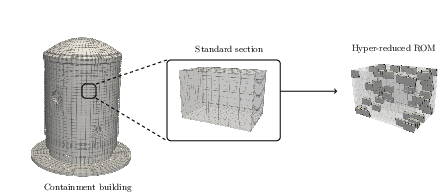
Visualization of different mechanical mesh levels for THM approaches to concrete ageing for nuclear containment buildings.
8.3 Deep learning wall laws for aerodynamic simulations
Participants: Michel Bergmann, Michele Romanelli.
RANS simulations are widely used in the industrial field. However, their accuracy heavily depends on solving the near-wall flows, typically requiring a very fine mesh to properly capture the strong gradients that develop in the boundary layer. This results in a significant impact on the computational cost of the simulation. Wall laws help mitigate these computation requirements by replacing the resolution of the boundary layer with modeling. In this context, deep learning-based approaches are being explored, and the flexibility of neural networks offers undeniable potential in wall flow modeling.
This work aims to develop a deep learning-based wall law that can accurately reproduce the evolution of the inner region of the boundary layer, thus providing valid boundary conditions for RANS calculations conducted away from the wall.
The approach involves training neural networks to estimate wall shear stress and reconstruct velocity profiles by modeling the boundary layer evolution. These neural networks are trained on fully resolved RANS simulations of turbulent flows over various 2D bump geometries. The performance, in terms of accuracy and computational cost, of this model is then compared to calculations resolved up to the wall for flow configurations not included in the training dataset. The method has proven its accuracy, with only a few percent of error on the friction coefficient, and allows for a significant reduction in computation time and iterations compared to a fully resolved RANS simulation.
These results pave the way for extensions to complex flow configurations, especially in cases of separation, or adaptation for applications within the immersed boundary method (IBM) framework.
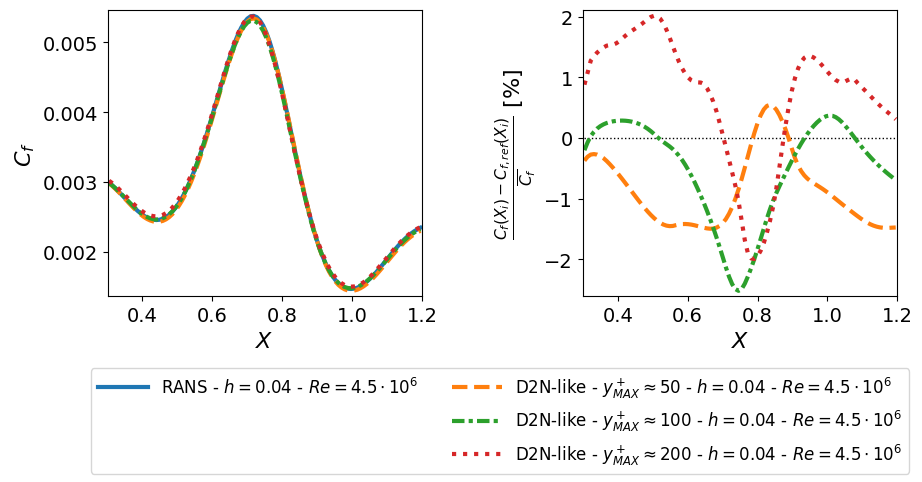
Skin friction coefficient (left) and the relative local error (right) between the reference wall resolved simulation and wall modeled ones. Selected sample case illustrating interpolation conditions across unseen bump height and Reynolds number with reference to training dataset. RANS-wall model interface placed at .
8.4 Data-driven models for turbulent separated flows
Participants: Thomas Philibert, Angelo Iollo.
Data-driven methods offer significant potential to improve turbulence modeling by addressing challenges related to accuracy and efficiency in computational tools for aerospace engineering. One of the key challenges in this field is balancing the need for accuracy with computational efficiency. Although Reynolds-averaged Navier-Stokes (RANS) models are widely used because of their low computational cost, they rely on the Boussinesq approximation for turbulence closure, which assumes a linear relationship between the Reynolds stress tensor and the strain rate tensor. This assumption often fails for complex flows that involve separation, transition, or other nonlinear phenomena.
This study aims to enhance the predictive capabilities of the SST RANS model by introducing non-linear correction terms that address the limitations of the Boussinesq approximation. These corrections are expressed as functions of tensor invariants, providing a physically consistent framework that ensures Galilean invariance. Two key contributions of this work are:
- Robust and simplified nonlinear corrections: novel formulations are proposed to improve the accuracy of turbulence closure models while maintaining computational efficiency. Simplified relationships between non-linear corrections and invariants are tested to enhance reliability across a broad range of flow conditions.
- Physics-informed Machine Learning: physical constraints are embedded into the training process through penalization methods, ensuring the corrections remain consistent with the underlying physics. This approach increases the robustness of the model compared to previous data-driven methodologies, which often struggled with inconsistencies.
The proposed framework is versatile, applicable to both compressible and incompressible flows, and has the potential to improve the design of aerospace propulsion systems by enabling accurate yet computationally efficient simulations. By advancing RANS models, this work contributes to the development of greener propulsion technologies for civil aviation and supports innovations in urban air mobility.
In conclusion, we present the velocity error for a benchmark case from the literature: the flow over a periodic hill. This case serves as a reference test for assessing the predictive capability of RANS models on separated flows. The configuration features complex flow phenomena, including separation on the curved surface, reattachment on the flat surface, and an unstable shear layer surrounding the primary recirculation bubble. The reference solution is obtained from a DNS simulation. As shown in the Fig. 13, the solution provided by the proposed model demonstrates a reasonable and precise agreement with the DNS solution. Further numerical investigations can be found in the doctoral thesis of Thomas Philibert.

Pointwise error between the recovered velocity and the DNS reference velocity.
8.5 Aeroelastic modelling of large transformations using partitioned coupling: application to large wind turbines
Participants: Michel Bergmann, Caroline Le Guern.
Decarbonizing the energy sector is essential to achieving the climate goals set by the International Renewable Energy Agency (IRENA). By 2050, wind energy could account for more than one-third of global electricity production, requiring a significant expansion of both onshore and offshore wind installations. This rapid growth brings technical challenges, particularly in the aeroelastic modeling of modern wind turbines. Floating offshore turbines, for example, operate in unsteady wind conditions where existing low-fidelity aerodynamic models face significant limitations. Among these models, the Blade Element Momentum (BEM) method 47, 41 is widely used due to its computational efficiency, but its reliance on simplifying assumptions and correction models reduces its accuracy for next-generation turbine designs.
The PhD thesis of Caroline Le Guern in collaboration with IFPEN investigates the Free Vortex Wake (FVW) method 39, 43 as a higher-fidelity alternative to BEM. The FVW method provides a more detailed representation of complex phenomena, such as unsteady blade dynamics and blade-wake interactions. However, its high computational cost presents a major challenge, particularly for aeroelastic simulations, where the aerodynamic solver must be coupled with a structural solver to compute the structural displacements induced by aerodynamic forces accurately. To overcome this limitation, partitioned coupling approaches 44 were studied to improve computational efficiency without compromising accuracy. A specific focus was placed on implementing a subcycling scheme within the aeroelastic framework, allowing the aerodynamic and structural solvers to operate independently with different time steps. The performance of this subcycling scheme was compared to the Conventional Serial Staggered (CSS) scheme, which had been the standard prior to this work. The evaluation considered accuracy, stability, and computational time for a IEA 15MW turbine 45 under operational conditions. Results demonstrated a significant reduction in computational time, up to 400 times faster, with minimal impact on accuracy when using the subcycling scheme. These findings highlight the potential of higher-fidelity methods like FVW for aeroelastic modeling of large offshore wind turbines, paving the way for more efficient and precise simulations of modern turbine designs.
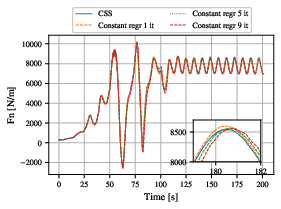
Sectional aerodynamic forces comparison for CSS method and subcycling scheme using constant regression at radius location .
| Method | CSS | 1 sub-it | 2 sub-it | 4 sub-it | 7 sub-it | 9 sub-it |
| Total comp. time | 10d16h | 35h06min | 11h24min | 2h55min | 57min | 36min |
8.6 Towards risk assessment of abdominal aortic aneurysms through geometric modeling and reduced order hemodynamic simulations
Participants: Angelo Iollo, Ludovica Saccaro.
The PhD work of Ludovica Saccaro 27 focuses on abdominal aortic aneurysm (AAA), a pathology characterized by the localized weakening and bulging of the aortic wall, leading to disturbed blood flow and potential rupture. The primary contribution of this work is a geometric modeling procedure within a mathematical framework. This involves isolating the infra-renal region containing the aneurysm from a 3D digital twin of the aorta, reconstructed from CT scans using software developed by NUREA start-up. The geometric modeling we propose analyzes each aneurysm's geometry by identifying the centerline of the aortic vessel, approximating it with B-splines functions, and subdividing the aortic wall into sections modeled with Fourier series, by cutting it on the planes transverse to the centerline. This forms the basis for various applications using a reduced order modeling approach.
We first exploit the geometrical modeling for post-operative follow-up. Post-operative follow-up involves registration, a method used to monitor disease progression in a patient by comparing images or 3D reconstructions from different examinations. In general, traditional registration methods, though accurate, are insufficiently fast for clinical needs. The proposed parameterization-based registration method automates the process, starting from CT scans and providing a compact mathematical representation of the aneurysm's geometry through the modeling detailed above. This allows for quantitative comparison of geometric changes, using techniques like the Iterative Closest Point (ICP) algorithm for rigid registration.
Geometrical model can be also linked with results of hemodynamical simulation, in particular with the purpose of assessing rupture risk. Compared to the currently used maximum diameter criterion, hemodynamic patient-specific indicators from computational fluid dynamics (CFD) simulations can better assist clinicians. However they require detailed aneurysm modeling lengthy simulations and elaborate results post-processing. The goal of the proposed method is to link patient-specific geometry with hemodynamic indicators using reduced order models to expedite the process, while systematically interpreting simulation data. First simulations are carried with SimVascular, then indicators measurements are derived from post-processing. Then Proper Orthogonal Decomposition (POD), a reduced modeling technique, is used to project indicators fields onto low-dimensional spaces. Radial Basis Functions (RBF) link the geometric information with indicators data in the reduced space. Finally, introducing an unknown modeled geometry, and exploit the mathematical relation, indicators are calculated for the new patient.
The third application proposed is a data generation pipeline to automate data augmentation, for in-silico experiments, optimizing personalized treatments and therapies and aiding clinical decision-making while safeguarding patient privacy. Each aneurysm is identified by its geometric parameters, treated with reduced modeling techniques to derive latent variable space representing initial data, from which statistically relevant samples are extracted, and a new aneurysms are assembled. This work bridges patient-specific clinical data with generative algorithms, using reduced order modeling and a machine learning approach to create data generators.
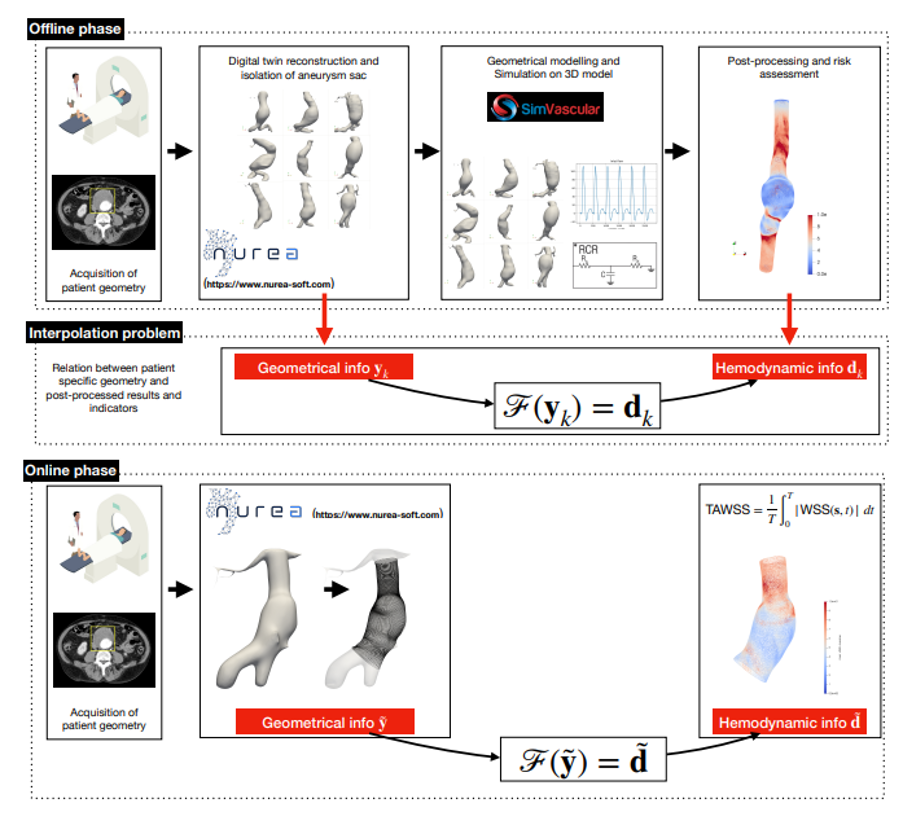
We develope a pipeline with the goal of predicting a risk indicators field on the aneurysm wall, starting from the geometrical modeling of the aneurysm. We work within a reduced-order model framework, thus identifying an offline and an online phase. During the offline phase, geometrical modeling, Computational Fluid Dynamics (CFD) simulations, and computation of indicators on the aortic wall are conducted for each of the aneurysm in the dataset. Given the offline nature, considerations of time consumption are not taken into account. Then the geometry and wall indicators are interconnected using a Radial Basis Function (RBF) interpolant. The online phase involves introducing an unknown modeled geometry, and exploit the interpolant to extract the indicator distribution on the wall..
9 Bilateral contracts and grants with industry
9.1 Bilateral contracts with industry
Participants: Michel Bergmann, Angelo Iollo, Tommaso Taddei.
- Contrat accompagnement Cifre Ingeliance (M. Truel) - du 01/05/2023 au 30/04/2026
- Contrat accompagnement EDF (E. Agouzal) - du 01/04/2021 au 30/03/2024
- Contrat accompagnement IFPEN (C. Le Guern) - du 01/12/2021 au 30/11/2024
- Contrat accompagnement EDF (A. Moussaddak) - du 01/12/2023 au 30/11/2026
10 Partnerships and cooperations
10.1 International initiatives
10.1.1 Associate Teams in the framework of an Inria International Lab or in the framework of an Inria International Program
Participants: Michel Bergmann, Alessia Del Grosso, Angelo Iollo, Tommaso Taddei.
ROHM
-
Title:
Reduced Order Hybrid Models
-
Duration:
2023 ->
-
Coordinator:
Charbel Farhat (cfarhat@stanford.edu)
-
Partners:
- Stanford University Stanford (États-Unis)
-
Inria contact:
Angelo Iollo
-
Summary:
The ROHM project is devoted to mathematical models that combine partial differential equations and prior solutions of such models in order to reduce the size of the problem. In particular, building on the collaboration previously undertaken in the previous associated MARE team, it is intended to explore two complementary aspects of reduced modeling. On the one hand, it is intended to combine the notion of solution mapping learned in the solution space developed at Bordeaux with the projection space partitioning technique developed at Stanford. On the other hand, it is intended to combine low-fidelity models and high-fidelity models in physical space or time in order to be able to deal with strongly multiscale problems.
SPADES_EA
-
Title:
Structure-Preserving Approximations of Dynamical systems in Engineering and Science
-
Duration:
2024 ->
-
Coordinator:
Benjamin Sanderse (b.sanderse@cwi.nl)
-
Partners:
- CWI Amsterdam (the Netherlands)
-
Inria contact:
Tommaso Taddei
-
Summary:
Model order reduction (MOR) of parametric PDEs is a well-established field in scientific computing that aims to reduce the marginal cost associated with the solution to parametric systems: MOR is motivated by many-query (optimization, parameter sweeps) and real-time (interactive design, monitoring) applications, which naturally arise in the field of continuum mechanics. Despite the numerous examples of applications of MOR to large-scale industrial problems, the practical deployment of MOR techniques remains limited in computational fluid dynamics (CFD). To address the current limitations of MOR methods, several authors have proposed structure-preserving projection techniques and nonlinear data compression methods: the former refer to a class of methods that aim to preserve notable properties (e.g., positivity, entropy conservation) of the solution to the underlying PDE, which are not necessarily guaranteed at the reduced-order level; the latter refer to a class of methods that exploit a nonlinear ansatz to estimate the state field. The objective of the Associate Team SPADES between Inria Team MEMPHIS (PI: Tommaso Taddei) and CWI (PI: Benjamin Sanderse) is to devise effective structure-preserving nonlinear model reduction techniques for unsteady nonlinear PDEs that arise in computational fluid dynamics (CFD). The project benefits from the very complementary expertise in nonlinear approximation methods and structure-preserving reduced-order formulations of the two partners, and has the potential to address the grand challenges of model reduction techniques for a broad range of applications in CFD.
10.1.2 H2020 projects
ARIA
ARIA project on cordis.europa.eu
-
Title:
Accurate Roms for Industrial Applications
-
Duration:
From December 1, 2019 to November 30, 2024
-
Partners:
- INSTITUT NATIONAL DE RECHERCHE EN INFORMATIQUE ET AUTOMATIQUE (INRIA), France
- ESTECO SPA (ESTECO), Italy
- NUREA, France
- VALOREM SAS (valorem), France
- UNIVERSITA DEGLI STUDI DI TRIESTE (UNITS), Italy
- SCUOLA INTERNAZIONALE SUPERIORE DI STUDI AVANZATI DI TRIESTE (SISSA), Italy
- IEFLUIDS S.R.L., Italy
- POLITECNICO DI TORINO (POLITO), Italy
- CONSERVATOIRE NATIONAL DES ARTS ET METIERS (CNAM), France
- POLITECNICO DI MILANO (POLIMI), Italy
- OPTIMAD ENGINEERING SRL (Optimad srl), Italy
- UNIVERSITY OF SOUTH CAROLINA (USC), United States
- VOLKSWAGEN AKTIENGESELLSCHAFT (VW AG), Germany
- VIRTUALMECHANICS SL (VM), Spain
- VIRGINIA POLYTECHNIC INSTITUTE AND STATE UNIVERSITY (VT), United States
- UNIVERSITA CATTOLICA DEL SACRO CUORE (UCSC), Italy
- BOARD OF TRUSTEES OF THE LELAND STANFORD JUNIOR UNIVERSITY (STANFORD), United States
- UNIVERSIDAD DE SEVILLA, Spain
-
Inria contact:
Angelo IOLLO
-
Coordinator:
Angelo IOLLO
-
Summary:
The project Accurate Roms for Industrial Applications aims at developing a range of mathematical methods for constructing predictive reduced-order models (ROMs) with guaranteed accuracy, robustness, reliability and efficiency for applications involving complex physical phenomena. New approaches to this challenge are proposed here with a focus on the Euler and Navier-Stokes equations of fluid flow, two of the most challenging continuum models with an extraordinary rich range of industrial applications. The mathematical modeling and solution of the Euler and Navier-Stokes equations is sometimes cited as the greatest challenge in continuum modeling of physical phenomena. This topic is selected as our principal focus because of its intrinsic importance, but also because the mathematical methods developed in addressing this very challenging task may well have an impact on other fields of knowledge. We plan to tackle these challenging objectives in this staff exchange program by combining the unique expertise of our extended research team whose members have made significant progress in ROM research during the past decade. This academic expertise is cross-fertilized by the exchange with knowledge intensive SMEs ans start up and well established industrial partners that will benefit from the scientific and technological results of the team and will challenge the solutions found with applications in real world problems.
10.2 National initiatives
-
ANR (national agency for research funding)
DRAGON2.
- Principal investigators: Michel Bergmann.
- Partners: CNRS/Université de Poitiers/Inria. 27 k€+ 1 PhD.
- Summary: The goal is study the aquatic swimming a several snakes using biomimetism and bioinspiration. In this project, we have experimental data for snake swimming, and we are building a numerical twin to compute integral quantities like the efficiency. Reinforcement learning is also considered to optimize the snake swimming.
-
ANR (national agency for research funding)
RedLum.
- Principal investigators: Tommaso Taddei.
- Partners: Team ACTA at INRAE Rennes.
- Summary: REDLUM is a joint project between the team ACTA at INRAE Rennes and the team MEMPHIS at Inria Bordeaux; the project will fund a PhD thesis in October 2024: the selected student will join team MEMPHIS in Bordeaux and will work closely with the other partners of the project. The objective of REDLUM is to develop a model reduction procedure for turbulent flows with unknown boundary conditions; the ultimate goal is to devise a rapid and reliable simulation tool to tackle real-time data assimilation tasks in agricultural sciences. The distinctive methodological feature of the approach that we wish to develop is a stochastic closure model to adequately approximate the dynamics of the low-dimensional coherent structures of the system.
-
Inria Exploratory Action: AM2OR (Adaptive meshes for model order reduction).
- Principal investigators: Nicolas Barral (Inria team: Cardamom), Tommaso Taddei. 14 k€+ 1 PhD + 1 PostDoc.
- Summary: Mesh adaptation and model order reduction both aim at reducing significantly the computational cost of numerical simulations by taking advantage of the solution's features. Model order reduction is a method that builds lighter surrogate models of a system's response over a range of parameters, which is particularly useful in the solution of design and optimization inverse problems. Reduced-order models rely on a high-fidelity (e.g., finite element) approximation that should be sufficiently accurate over the whole range of parameters considered: in presence of structures such as shocks and boundary layers, standard mesh refinement techniques would lead to high-fidelity models of intractable size. In this project, we propose a novel adaptive procedure to simultaneously construct a high-fidelity mesh (and associated discretisation) and a reduced-order model for a range of parameters, with particular emphasis on inverse problems in computational fluid dynamics.
11 Dissemination
11.1 Scientific events: organisation
Michel Bergmann, Angelo Iollo and Tommaso Taddei organized the 2024 CEA-EDF-Inria summer school on numerical analysis. See section 6 for further details.
Michel Bergmann, Angelo Iollo and Tommaso Taddei organized the ARIA final workshop in Trieste.
Michael Dumbser, Angelo Iollo, Raphael Loubère, Mario Richhiuto, Andrea Thomann organized PANDA-Hyp 2 day conference in honour of 65th anniversary of Gabriella Puppo. https://indico.math.cnrs.fr/event/11876/
11.2 Invited talks
Michel Bergmann gave an invited talk at the workshop on “Numerical analysis, control, and optimization for physics” in Sophia Antipolis and at a workshop on fluid-structure interaction at Inria Paris.
Tommaso Taddei gave a plenary invited talk at the conference MORE and two invited talks at the workshop on “Uncertainty quantification for high-dimensional problems” at CWI Amsterdam and at the ARIA final workshop in Trieste.
Michel Bergmann, Alessia Del Grosso, Angelo Iollo and Tommaso Taddei gave invited talks at minisymposia of several international conferences (ECCOMAS Lisbonne, ALGORITHMY SLovacchia, ICCFD Kobe, WCCM Vancouver and SIAM UQ Trieste)
11.3 Leadership within the scientific community
Michel Bergmann was an elected member of the Inria Commission d'Evaluation in 2022 and 2023, and is an appointed member since 2024. He is Délégué Scientifique Adjoint (DSA) of the Inria center in Bordeaux since July 2024; he was correspondant scientifique of the DRI for the center of Bordeaux from June 2022 to December 2024. He is a member of the scientific committee of the institute of mathematics in Bordeaux (IMB) and is the IMB representative at the Conseil Scientifique du méso-centre aquitain MCIA.
Angelo Iollo is PI with Denis Sipp of Onera of the Chair PROVE, endowed by a grant of Region Nouvelle Aquitaine and Onera. The chair is endwed with PhD grants, PostDocs and funding for research animation.
11.4 Teaching - Supervision - Juries
11.4.1 Teaching
Two members of the team are Professor (Angelo Iollo) or Assistant Professor (Afaf Bouharguane) at Université de Bordeaux and have teaching duties, which consist in courses and practical exercises in numerical analysis and scientific computing. Michel Bergmann (CR) also teaches around 64 hours per year (practical exercises in programming for scientific computing). Tommaso Taddei (CR) also teaches around 50 hours per year (practical exercises in numerical analysis and scientific computing).
11.4.2 Supervision
Michel Bergmann supervises or co-supervises the PhD theses of Maxime Chapron, Caroline Le Guern, Eki Agouzal, Mathias Truel, Michele Romanelli, Beatrice Battisti, and Karl Maroun.
Angelo Iollo supervises or co-supervises the PhD theses of Jon Labatut, Elise Declerk, Ludovica Saccaro, Thomas Philibert, Mathias Truel, Marc-Oliveir Potin and Alexis Valls.
Tommaso Taddei supervises or co-supervises the PhD theses of Eki Agouzal, Jon Labatut, Abdessamad Moussaddak, Ishak Tifouti and Alexis Valls.
11.4.3 Juries
Michel Bergmann was a member of the jury for the HDR of Laeticia Giraldi (Inria Nice) and the president of the jury for the HDR Simon Labarthe (University of Bordeaux); he was also the president of the jury of the PhD thesis of Thomas Philibert (Inria Bordeaux); he further reviewed the PhD thesis of Peder Jørgensgaard Olesen at DTU (Danemark) and Daniele Corti (Sorbonne University). Finally, he served in the Inria final selection board (jury'admission) for the recruitment of DR2 and CRCN researchers, and in the preliminary selection board (jury d'admissibilité) for the recruitment of CRCN researchers.
Angelo Iollo was president of the PhD jury of the thesis of Beatrice Battisti, Politecnico di Torino and Université de Bordeaux, the thesis of Narimane Gassa Université de Bordeaux, the thesis of Caroline Le Guern IFPEN and Université de Bordeuuax. He was also reviewer of the PhD thesis of Igor Maingonnat at the University of Rennes.
Tommaso Taddei was a member of the jury for the PhD theses of Bruno Vuillod (ENSAM Bordeaux), Willy Haik (Sorbonne University), Thomas Philibert (Inria Bordeaux).
11.5 Popularization
11.5.1 Specific official responsibilities in science outreach structures
Michel Bergmann was a member of the CUMI-R committee, (until July 2024) and is a member of the CDT. He also leads the storytelling efforts for the Energy research axis at Inria Bordeaux.
Tommaso Taddei is a member of the CUMI-R committee and of the CDT.
12 Scientific production
12.1 Major publications
- 1 articleAn all-speed relaxation scheme for gases and compressible materials.Journal of Computational Physics3512017, 1-24HALDOI
- 2 articleFluid--solid Floquet stability analysis of self-propelled heaving foils.Journal of Fluid Mechanics9102021, A28HALDOI
- 3 articleEnablers for robust POD models.Journal of Computational Physics22822009, 516--538
- 4 articleAn accurate cartesian method for incompressible flows with moving boundaries.Communications in Computational Physics1552014, 1266--1290back to text
- 5 articleBioinspired swimming simulations.Journal of Computational Physics3232016, 310 - 321
- 6 articleModeling and simulation of fish-like swimming.Journal of Computational Physics23022011, 329 - 348
- 7 articleAccurate Asymptotic Preserving Boundary Conditions for Kinetic Equations on Cartesian Grids.Journal of Scientific Computing2015, 34
- 8 articleNumerical solution of the Monge--Kantorovich problem by density lift-up continuation.ESAIM: Mathematical Modelling and Numerical Analysis4961577November 2015
- 9 articleA Cartesian Scheme for Compressible Multimaterial Models in 3D.Journal of Computational Physics3132016, 121-143back to text
- 10 articleEnablers for high-order level set methods in fluid mechanics.International Journal for Numerical Methods in Fluids79December 2015, 654-675
- 11 articleIntensity of vortices: from soap bubbles to hurricanes.Scientific Reports3December 2013, 3455 (1-7)
- 12 articleA numerical study of two dimensional flows past a bluff body for dilute polymer solutions.Journal of Non-Newtonian Fluid Mechanics1962013, 8-26
12.2 Publications of the year
International journals
International peer-reviewed conferences
National peer-reviewed Conferences
Scientific book chapters
Doctoral dissertations and habilitation theses
Reports & preprints
12.3 Cited publications
- 36 articleA penalization method to take into account obstacles in a incompressible flow.Numerische Mathematik8141999, 497-520back to text
- 37 articleExact and approximate solutions of Riemann problems in non-linear elasticity.Journal of Computational Physics228182009, 7046-7068back to text
- 38 articleSecond order ADER scheme for unsteady advection-diffusion on moving overset grids with a compact transmission condition.SIAM Journal on Scientific Computing4412022, A524--A553back to text
- 39 miscWind Turbine Aerodynamics and Vorticity-Based Methods.2020back to text
- 40 articleA Cartesian scheme for compressible multimaterial models in 3D.Journal of Computational Physics3132016, 121-143URL: http://www.sciencedirect.com/science/article/pii/S0021999116000966DOIback to text
- 41 bookWind energy handbook.John Wiley & Sons2011back to text
- 42 articleAn experimental study of entrainment and transport in the turbulent near wake of a circular cylinder.Journal of fluid mechanics1361983, 321--374back to text
- 43 phdthesisaero-elastic modeling of floating wind turbines with vortex methods.Marne-la-vallée, ENPC2022back to text
- 44 articleProvably second-order time-accurate loosely-coupled solution algorithms for transient nonlinear computational aeroelasticity.Computer methods in applied mechanics and engineering19517-182006, 1973--2001back to text
- 45 articleDefinition of the IEA 15-megawatt offshore reference wind turbine.2020back to text
- 46 articleModelling wave dynamics of compressible elastic materials.Journal of Computational Physics22752008, 2941-2969back to text
- 47 articleAirplane propellers.Aerodynamic theory1935back to text
- 48 bookElements of continuum mechanics.Nauka Moscow1978back to text
- 49 articleMapping of coherent structures in parameterized flows by learning optimal transportation with Gaussian models.Journal of Computational Physics4712022, 111671URL: https://www.sciencedirect.com/science/article/pii/S0021999122007343DOIback to textback to textback to text
- 50 phdthesisConstruction d'une chaîne d'outils numériques pour la conception aérodynamique de pales d'éoliennes.Université de Bordeaux2014back to text
- 51 articleA Conservative Three-Dimensional Eulerian Method for Coupled Solid-Fluid Shock Capturing.Journal of Computational Physics18312002, 26-82back to text
- 52 bookLevel Set Methods and Fast Marching Methods.Cambridge University Press, Cambridge, UK1999back to text
- 53 articleA registration method for model order reduction: data compression and geometry reduction.SIAM Journal on Scientific Computing4222020, A997--A1027back to textback to text

